In the modern landscape where e-commerce and global trade are witnessing exponential growth, effective supply chain visibility has emerged as a crucial factor driving business growth and customer satisfaction. The catalyst igniting this significant shift is the advancement in rail freight tracking—a process meshing technology and logistics to yield clearer, more insightful supply chain visibility.
Our essential guide focuses on how advanced rail freight tracking fosters resource optimization and enhances business results. We’ll delve into how it contributes to resource optimization, strengthens control over supply chain operations, and enhances bottom-line results. We navigate the historical trajectory, scrutinize the opportunities and challenges presented, and cast light on how Rail Command®—a ground-breaking solution in rail freight tracking—paves the road to unparalleled supply chain transparency.
Venture with us into the intricate world of sophisticated rail freight tracking. This voyage is intended to inform and educate, whether you’re just dipping your toes into the industry, or you are a well-versed professional. Consider this guide as an essential tool in understanding and executing advanced rail freight tracking in your operation.
Streamlining Modern Supply Chains Through Efficient Rail Freight Management
Mastering supply chain visibility can seem like a daunting task in today’s fast-paced, consumer-driven market. As you navigate this intricate network, a notable challenge you’ll encounter is rail freight management—a critical component for you to construct a holistic understanding of your supply chain and optimize its efficiency.
The Role of Rail Freight in Supply Chain Management
Rail freight plays an undeniably pivotal role in supply chain management, illustrating a significant touchpoint in the transportation of goods across vast distances. Its capability to transport substantial quantities of cargo in a single trip makes it a preferred mode of transport for businesses dealing with large-scale transactions. This extends to various sectors, including manufacturing, retail, agriculture, and energy, among others. Given the widespread dependency on rail freight, it becomes imperative that its management is efficient, reliable and transparent.
Overcoming Supply Chain Complexity with Data-Driven Approach
With the expansion of global networks, businesses shoulder the responsibility of managing multifold touchpoints, each bearing explosive potential for disruptions. Inaccuracies or outdated details can derail decision-making, which in turn affects cost efficiency and customer satisfaction rates. A data-driven approach is needed for you to maintain an efficient rail freight management operation.
A crucial factor in this process is real-time data availability. Absence of timely information on shipment details puts businesses like yours at risk of missing out on potential delivery setbacks, hampering your prompt reaction to unforeseeable incidents or delays.
The quest for end-to-end visibility is further complicated with the use of multiple tracking systems; this can lead to a deficit in standardization, and it is an arduous task for you to resolve this challenge.
The Unique Challenges in Rail Freight Management
In the context of rail freight management, the challenges amplify. The rail industry grapples with dated legacy systems, hands-on operations, and lack of streamlined data sharing. Coupled with vast the geographical distances that railroads traverse, near-instant, location-focused cargo tracking becomes notably tricky.
Understanding these challenges reveals the significance of integrated, automated solutions like Rail Command®.
The Consequence of Effective Rail Freight Management
With the digital transformation in logistics, rail freight management has evolved beyond just keeping pace with technology. The primary goal is attaining total supply chain visibility, making each node or transition point pivotal. Efficient tracking of rail freight is subsequently a fundamental element of robust supply chain management.
Key benefits of effective rail freight management involve:
- Improved Inventory Management: Streamlining forecast execution and inventory management is achievable with reliable, real-time transit status information. Mitigating the risks of stockouts, overstocks, or excess safety stocks directly influences the company’s profitability.
- Enhanced Customer Service: Today’s customer seeks continuous updates about their order’s journey. Businesses can meet this expectation through efficient rail freight tracking, leading to improved customer satisfaction.
- Optimized Risk Management: Immediate attention and contingency implementation for unforeseen events, such as delays or cargo damage, is possible due to real-time rail freight visibility.
With effective rail freight management, you receive end-to-end visibility and improved overall supply chain efficiency. Next, we’ll take a historical look at the advances of modern rail freight tracking technology and optimizing rail freight tracking via automated software like Rail Command®.
The Evolution of Rail Freight Tracking: From Roots to Modern Technology
Tracing the Rail Freight Tracking Journey
Rail freight tracking has traversed a significant journey since its early days, aligning with the broader transportation sector’s evolution. Initially, it heavily leaned on manual processes and direct communication, which was resource-intensive and prone to inefficiencies, especially within expanding rail networks.
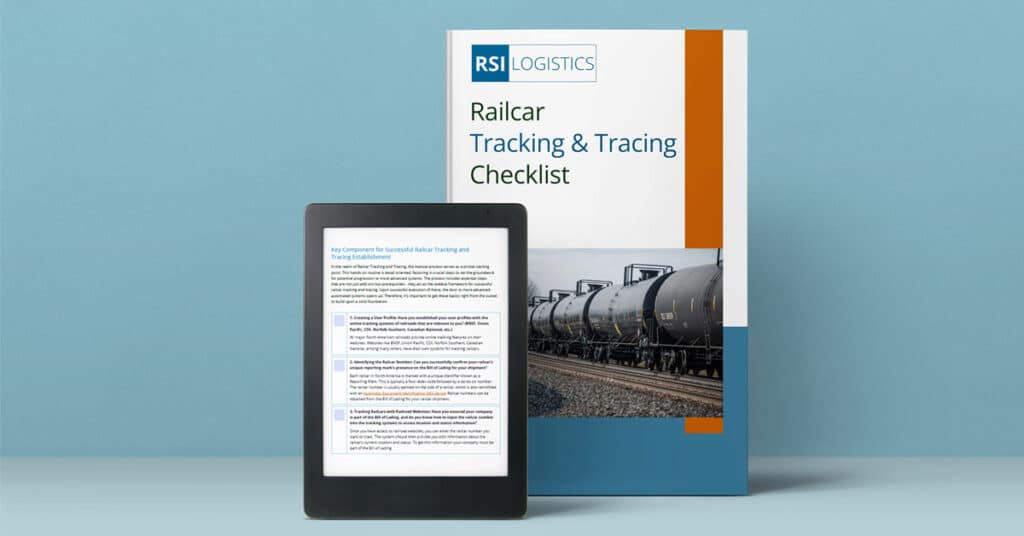
Navigating the Technological Advances in Rail Freight Tracking
Through technological advancement, rail freight tracking has progressively shifted from manual operations to increased automation and data-driven decision-making. Key milestones include:
- Computerized Systems: Pioneers in the digital revolution, these systems centralized train movements for optimized scheduling and resource allocation.
- Electronic Data Interchange (EDI) Systems: EDI, the computer-to-computer exchange of business documents in a standard electronic format, escalated visibility in rail freight management through streamlined data sharing and a minimization of human errors.
- Data Driven Optimization: Leveraging granular data and analytics, shippers were given a wealth of actionable insights to refine their strategies and bolster efficiency levels.
- Cloud-Based Management Platforms: Equipped with powerful data analytics tools, these platforms transformed rail freight tracking, allowing proactive bottleneck solutions and data-informed decisions.
Towards a Comprehensive Rail Freight Tracking
Today, rail freight tracking encompasses far more than mere shipment location. It’s about monitoring key performance metrics, ensuring regulatory compliance, and managing assets. Predictive analytics is now aiding in optimizing the entire rail freight process.
In the subsequent section, we’ll introduce Rail Command®, a modern software solution exemplifying current rail freight tracking technology capabilities.
Rail Freight Tracking as a Solution
Addressing Key Challenges in Supply Chain Visibility
Rail freight tracking, particularly when enhanced by digital technology, holds the answer to many of the challenges plaguing supply chain visibility today. By providing transparent and real-time status updates for shipments, it allows businesses to navigate the complexities of their supply chains more effectively.
Modern rail freight tracking systems can integrate with multiple tracking systems, thereby bringing standardization to the process. Coupled with the capabilities to record and analyze a vast array of data points instantaneously, these systems facilitate real-time decision-making, the cornerstone of effective supply chain management.
In the specific context of the rail industry, next-generation tracking technologies, which meld the power of cloud computing, IoT sensors, and data analytics, turn historical complexities into tangible solutions. They help transcend the vulnerabilities of conventional manual operations, outdated legacy systems, and the challenges of real-time location-specific goods tracking over large distances.
Key Benefits of Rail Freight Tracking
The use of advanced rail freight tracking systems brings about an array of key benefits:
- Operational Efficiency: Tracking systems enable effective resource allocation that minimizes underutilization and maximizes productivity. They also help detect bottlenecks and inefficiencies, allowing proactive remediation measures.
- Cost Savings: By eliminating delays and inefficiencies, tracking systems save not only time but also significant expenditure related to demurrage and detention costs.
- Accurate Forecasting: Real-time access to shipment data allows companies to make predictive analyses, enabling accurate forecasting of inventory needs, potential bottlenecks, and estimated delivery times.
- Improved Customer Satisfaction: Through timely and transparent communication, companies can meet their customers’ growing expectations, resulting in higher customer satisfaction rates.
- Risk Reduction: The ability to monitor shipments in real-time and preemptively detect potential interruptions allows companies to reduce the risk of delays or losses, thus enhancing risk management.
In the final part of this series, we’ll present examples for an innovative solution that’s perfecting the art of rail freight tracking: Rail Command®. As we explore how this software harnesses the power of modern technology, you’ll get a clearer vision of the future of supply chain visibility.
Rail Command®: Your Partner for Efficient Rail Freight Tracking
A Beacon of Automation in Rail Freight Management
Rail Command® represents a paradigm shift in rail freight tracking, acting as a lighthouse to guide you through the ups and downs of the logistics ocean. Boasting of an intelligent, automated system, this software is built to integrate seamlessly with your operations, providing a complete, real-time view of your rail freight’s journey.
Designed with efficiency and simplicity in mind, Rail Command® aims to revolutionize rail freight management, leveraging the best of modern technology to offer unprecedented control and visibility over your shipments.
Key Features and Benefits
Rail Command® brings to the table a plethora of innovative features that redefine the narrative of rail freight tracking:
Near-Instant Tracking:
Through the power of rail tracking technology and advanced data analytics, it offers accurate location and status of your shipments, providing a single source of truth for all your tracking needs.
Automated Alerts:
To keep you updated about your shipments, Rail Command® generates automated alerts for significant events or potential disruptions, ensuring proactive management of any situation.
Customized Reporting:
It allows you to tailor reports according to your needs and preferences, enabling data-driven decisions and strategic planning.
Improved Efficiency:
By ensuring end-to-end visibility, Rail Command® drastically reduces the time spent on tracking and monitoring, thus freeing up resources for other critical tasks.
Cost Savings:
By optimizing logistics processes and ensuring timely deliveries, it guarantees substantial savings in terms of demurrage and detention costs.
Real-World Applications: The Transformative Impact of Rail Command®
Case Study 1: Advanced Track and Trace Accuracy Ensures Efficiency
One notable case study highlights how Rail Command®’s outstanding track and trace accuracy—in the 90th percentile—allows transportation professionals to proactively identify and tackle issues. This level of precision ensures that businesses can stay substantially ahead of problems, ensuring smooth rail operations and bolstering their bottom line.
Case Study 2: Custom Reporting – Merging Efficiency with Automation
Rail Command® revolutionized the data management processes of a client grappling with the laborious task of collating information from several spreadsheets. Within Rail Command® was designed and implemented a custom report that, with a single click, auto-populates necessary shipment data. This tool streamlined efficiency, saving the client approximately three hours weekly.
Case Study 3: Resolving Demurrage Disputes with Significant Savings
A prime example of how Rail Command® can optimize operations comes from a real-life scenario where the software was instrumental in saving $479k in demurrage disputes from June 2021 to June 2023. The ability to pin down consistent crew issues and a switch in plant scheduling from five to two days a week facilitated holding the railroads accountable.
Embracing the Future of Rail Freight Management with Rail Command®
These case studies illuminate the transformative potential of Rail Command®. As we stride into the future of rail freight management, our solutions are at the forefront, taking the challenge of supply chain visibility and turning it into an easily monitored and controlled reality.
As the world evolves rapidly, efficient rail freight tracking has become critical in mastering the supply chain process. It is integral to the progress and client satisfaction you aim to achieve.
Rail Command® offers an innovative solution in navigating the ever-changing landscape of this industry. This tool empowers you to improve inventory control, boost customer satisfaction, and streamline risk management across vast geographical scopes.
As digital transformation revolutionizes logistics, moving beyond technological adaptation towards end-to-end supply chain visibility becomes essential. By embracing Rail Command®, you’re taking a significant step towards achieving this vision.
Your pursuit towards efficient rail freight tracking is not only a necessity but an investment in your supply chain, customer satisfaction, and business continuity. As your reliable partner, Rail Command® remains committed to helping you navigate this journey, reaching new heights in the logistics industry and beyond.


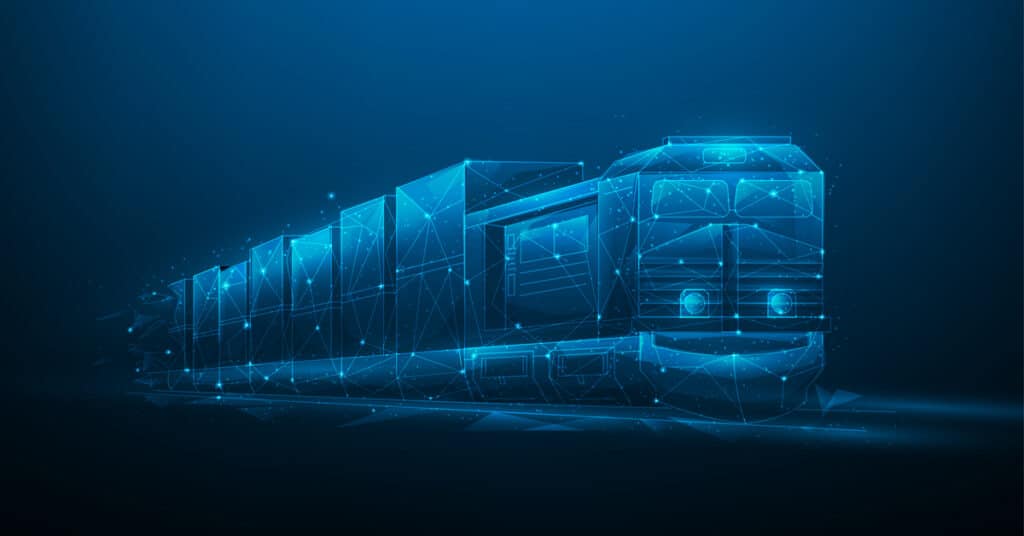
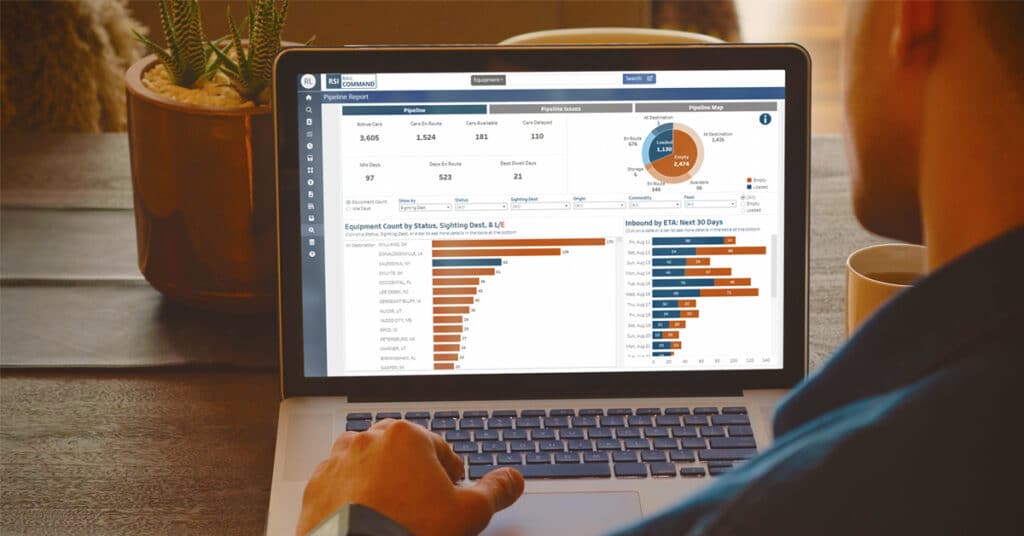

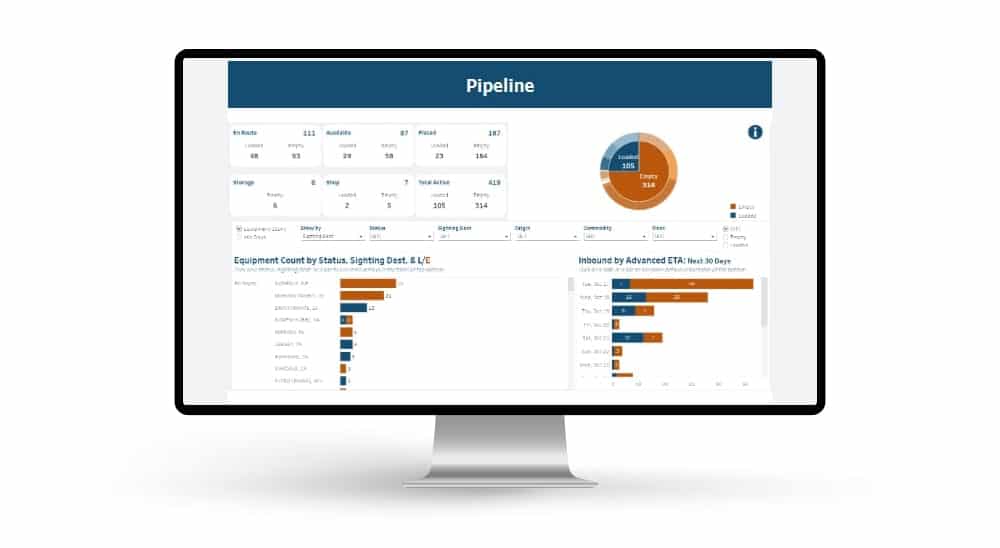 Automated exception reporting of the railcar tracking data makes it easy to identify and troubleshoot jeopardized shipments, thereby enabling you to provide better service to your stakeholders.
Automated exception reporting of the railcar tracking data makes it easy to identify and troubleshoot jeopardized shipments, thereby enabling you to provide better service to your stakeholders.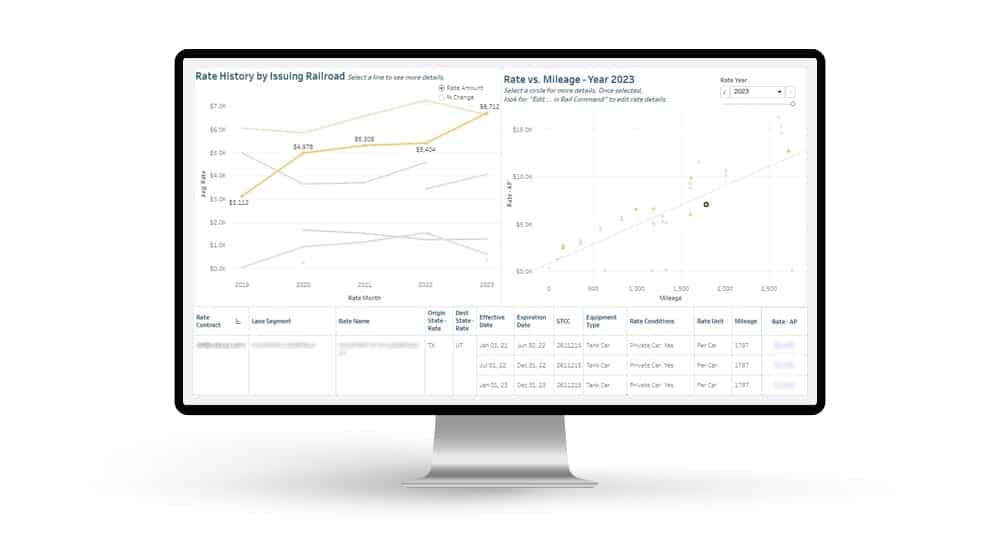 Receive notification of pending rate expirations. Tariff changes and fuel surcharges can be automatically updated.
Receive notification of pending rate expirations. Tariff changes and fuel surcharges can be automatically updated.